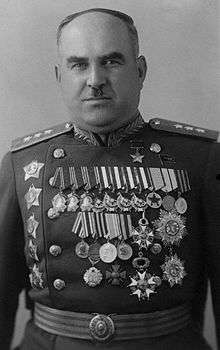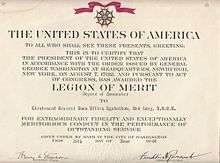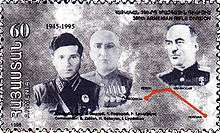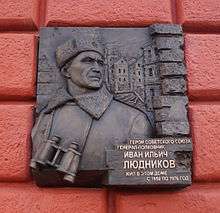Ivan Lyudnikov
| Ivan Ilyich Lyudnikov | |
|---|---|
 | |
| Native name | Иван Ильич Людников |
| Born |
8 October 1902 Krivaya Kosa, Don Host Oblast, Russian Empire |
| Died |
22 April 1976 Moscow, Soviet Union |
| Buried at | Novodevichy Cemetery |
| Allegiance |
|
| Service/branch | Soviet Army |
| Years of service | 1918-1968 |
| Rank | Colonel general |
| Commands held |
15th Rifle Corps |
| Battles/wars | |
| Awards |
|
Ivan Ilyich Lyudnikov, (Russian: Иван Ильич Людников; Krivaya Kosa ( Don Host Oblast, Russian Empire), 8 October [O.S. 26 September] 1902 – Moscow 22 April 1976) was a Soviet Army Colonel General and Hero of the Soviet Union.
Early life
Ivan Lyudnikov was born on 8 October 1902 in Krivaya Kosa in the Don Host Oblast. In 1913 he began working alongside his father at Mine No. 2 in the Shcheglovskogo Coal Mine. He became a coal sorter. In 1914 Lyudnikov became a drainage pump worker. He became an apprentice turner at the mine workshop in 1915 and in 1916 became a turner.
Russian Civil War
On 25 October 1917 Lyudnikov became a volunteer in the Yuzovsky Red Guard Group. In April 1918 he became a machine gunner in the special machine gun detachment commanded by Abrosimov on the Southern Front and was wounded. In May he became a Red Army man and a machine gunner in the detachment of S.A. Bondarenko. In December he transferred to the 1st Cavalry Regiment of the 42nd Rifle Division, part of the Semyon Budyonny's 1st Cavalry Army. Lyudnikov became a VKSLM member in 1919, elected by personnel of the 1st Cavalry Regiment. He became a Red Navy man serving on the gunboat Znamya sotsializma, under the command of Sergey Kolbasev, part of the Azov Flotilla and based at the Mariupol Naval Base. He fought against the White Army led by Alexey Kaledin, Anton Denikin and Pyotr Nikolayevich Wrangel during the Allied intervention in the Russian Civil War between 1918 and 1922.
Interwar
After the war was over, he was educated at the following military educational institutions :
- from 8 August 1922 till 1 January 1923 - 94 infantry commanding officer of the Ukrainian Military District;
- From 1 January 1923 till 8 August 1925 - Odessa infantry division;
- 1930 - Machine gun course at the Vistrel courses.
1925 - Commander at the 13th Dagestan infantry division, course and battalion course commander at the Vladikavkaz infantry school. In April 1935 Lyudnikov was sent to study at the Frunze Military Academy, from which he graduated on 8 September 1938.
Printed order 00128 of 29 August 1938 appointed him the special affairs officer of the Red Army 1st department. Starting with April 1939 he was leading 2 sections of the 13 branch department of the Red Army. Its main task was in preparing operations workers for army headquarters and commanding Zhitomir infantry school.
Great Patriotic war
The initial period of the war
By 22 of June 1941 colonel Lyudnikov was commanding 200th Rifle infantry division that was part of 31st Rifle Corps, in charge of military district and located south of the city of Sarny. Later, the 200th Rifle division was added to the 5th Army and took part of the Battle of Kiev. Occupying the Korosten fortified area, along with other units made numerous flank attacks on the 6th German Army aiming at Kiev. After being withdrawn from the river Dnieper, 200th division took part in defence fighting for Chernihiv. On the 12 of September the division and its staff was attacked from the air, as a result he was wounded seriously in the head, and his feet were broken. He was treated at Kharkiv hospital and then at Kazan military hospital #361. After his treatment was over, in November 1941, Lyudnikov received 16 separate infantry brigade, organized on the basis of Grozny and some other defence schools of North Caucasian defence district. The brigade was taken on the strength of the 56th Army's North Caucasus Military District. In late November the brigade took part in liberating Rostov-on-Don. Starting with 26 of March 1942 Ivan Iljich was at disposal of various units – the 218th Rifle Division North Caucasus Military District, the 404 Rifle Division, the 390th Armenian Rifle Division and the 63th Mountain Rifle Division of the 44th Army, but due to changes the situation at the front he did not take command of them. On 29 of May 1942 he began command of the 138 Rifle division, and was in its commanded for 9 months.
Battle of Stalingrad
138th Rifle Division was fighting the enemy in Stalingrad heroically in October - November 1942. 100 days and nighs the division conducted fighting at the Barrikady works in the area of Lower settlement. This territory of 700m. along the front and 400m in depth was encircled on three sides, the forth was Volga river. It was shot through by artillery, shot at by mines and shells. Division under Lyudnikov's command was fighting steadfastly till he proceeded to the final section of the report in December 1942. On the 25 of January 1943 division's units changed north to destroy the north group of the fascist units in the area of works and settlements. For courageous and brave operation shown by personnel in fighting for Stalingrad, the division was reorganized into the 70th Guards Rifle Division on February 6, 1943.
Battle of Kursk and Battle of the Dnieper
On the 1 of June 1943 Lyudnikov was appointed commander of the 15th guard infantry division carried out his orders on defence and then changed to counter offensive attack. On the 22 of September forward units approached Dnieper north of the city of Chernobyl and began forcing it without a pause. After seizing the bridge-head on the right bank they repulsed counterattacks and started battle for widening the bridge-head. He was taken note of successful management in forcing Dnieper and shown audacity and courage. He was afforded with the title of the Hero of the Soviet Union, presented with the order of Lenin and the Gold Star (N1892 of 16 of October 1943).
Operation Bagration
The Red Army performed attack operation "Bagration", called after the Russian commander in the Patriotic war of 1812. At the time Lydnikov was in command of 39 Army at the 3rd Belorussian Front. Together with 43 Army of the 1st Baltic Front In command of Army general Beloborodov made an attack operation against German forces. This operation is also known as Vitebsk–Orsha Offensive, or Vitebsk Orsha pocket. This operation resulted in liberation of 447 settlements in 4 days, including Vitebsk and Orsha.
Baltic Offensive
On decision of General Headquarters the authority of 39 Army was temporarily delegated to 1st Baltic front to take part in Baltic Offensive. The army was given the combat mission of seizing the line Daugavpils-Pabradė and further developing on offensive on Kaunas and Šiauliai. Daugavpils was liberated on 27 July, and then Panevėžys and Šiauliai. Kaunas was liberated on 1 August and the army came to the line Raseiniai-Suwałki, where suitable to defence on positions north of Neman at the borders of East Prussia. Further, Lyudnikov's forces received the tactical task of capturing the well equipped town of Tauragė, which allowed to block the main enemy's path from Tilsit across Neman. Army troops seized Tauragė and on 9 October crossed the border of German reich, getting down in history, entering Augstogallen. The army passed 150 km in 6 days of attack.
East Prussian Offensive
Ivan Chernyakhovsky, commander of the 3rd Belorussian Front set the tactical task to 39 Army that will put it into operation on the second day attack Kudirkos Naumiestis direction, Pilkallen, Hensnishkenen. The 39 army started the advance on October 17, encountered opposition and carried only 21 km in a week. 39th army carried on fighting. There was a foggy day on the 13 of January, when the art attack was appointed which made fire observation impossible. This made impossible the first day attack. 39 army could not achieve the planned results. The advance began to fade. I.Lyudnikov decided to carry all tanks and self-propelled guns south of Pilkallen, the direction that was considered secondary. The tanks were given the task of breaking through the defence line and carrying out the advance. Infantry has to apply all effort not to break from the tactical enemy and carrying out developing the success.If the breakthrough was successful, then developing it to north-west for Tilsit which will make the whole Insterburg group of German's see the threat of full surrounding. The weather (sleet snow) prevented starting the attack in the morning the snow was over by 16 hrs. The tanks made advance and by 22 hrs were 12–16 km in depth. A breach of the dam was formed ready for advance. On the 17th of January 1945 the 5 Guard and 94th Infantry courps broke through the Gumbinnen defence line and entered cities of Pilkallen and Hensnishkenen. The army forces seised Tilsit on the 19th of January. Further, 39 Army reached Dejma river. It took several days for the advanced divisions to cross the river by ferry. Army forces moved forward by 18 km. I.Lyudnikov received the task of creating the fortified defence line, made a roundabout way from the north, then from the west and reached the Baltic sea separating it from the German forces. Army forces seized it from railway station Metgethen separating communication from Königsberg to Pillau. On 16 April 1945 the Army forces seized the city of Fischhausen and this ended the fighting in East Prussia. Lyudnikov was promoted to Lieutenant general.
Soviet–Japanese War
From 12 May, the 39th Army began transfer to the Far East in preparation for the Soviet invasion of Manchuria. The 39th Army fought in the invasion of Manchuria. At the end of the war the army reached the Liaodong Peninsula, which it would garrison until the withdrawal of Soviet troops from China. For his leadership, Lyudnikov received the Order of Suvorov 1st class. He was also awarded the Medal "For the Victory over Japan", given to Soviet military personnel who participated in the campaign.
Commander of military forces
- 10 March 1941 – 14 September 1941 - 200th Rifle Division of Kiev Military District.
- 24 December 1941- March 1942 - 16th separate brigade of students
- 30 March 1942 - 18 April 1942 - 390th Rifle Division (1st formation)
- 29 May 1942 - 15 February 1943 - 138th Rifle Division
- 15 February 1943 - 1 June 1943 - 70th Guards Rifle Division
- 1 June 1943. - 27 May 1944 - 15th Rifle Corps
- 27 May 1944 - June 1947 - 39th Army, Lieutenant general, Colonel General.
Postwar
Lyudnikov was commandant of Port Arthur and commander of Soviet troops on the Liaodong Peninsula until 1947. On 29 November 1947, he became commander of the 10th Guards Army in the Leningrad Military District. On 20 April 1948, he became commander of the 13th Army in the Carpathian Military District. On 13 December 1949, Lyudnikov became deputy commander of the Group of Soviet Forces in Germany. In November 1951, he was sent to the Military Academy of the General Staff to take Higher Academic Courses, from which he graduated on 1 November 1952. On 28 November, he became deputy commander of the Odessa Military District. Lyudnikov transferred to command the Tauric Military District on 6 September 1954. On 10 June 1956, he became Warsaw Pact Supreme Command representative to the Ministry of National Defence of Bulgaria. Lyudnikov became commander of the Vystel Higher Officer Training Courses on 26 March 1959. On 28 November 1963, he became faculty head at the Military Academy of the General Staff. In late 1968, Lyudnikov retired. He died on 22 April 1976 in Moscow and was buried at the Novodevichy Cemetery.[1]
Honors and Awards



Soviet Orders and Medals
- Gold Star of the Hero of the Soviet Union # 1892 (16 October 1943)
- 3 Order of Lenin (22 February 1943, 16 October 1943, 21 February 1945)
- 5 Order of the Red Banner (27 March 1942, 27 August 1943, 3 November 1944, February 1968)
- 3 Order of Suvorov, 1st class (4 July 1944, 19 April 1945, 8 September 1945)
- Order of Suvorov, 2nd class (16 September 1943)
- Order of Bogdan Khmelnitsky (10 January 1944)
- Jubilee Medal "XX Years of the Workers' and Peasants' Red Army" (22 February 1938)
- Medal "For the Defence of Stalingrad" (1 May 1944)
- Medal "For the Defence of Kiev"
- Medal "For the Capture of Königsberg" (9 June 1945)
- Medal "For the Victory over Germany in the Great Patriotic War 1941–1945" (9 June 1945)
- Medal "For the Victory over Japan" (30 September 1945)
- Medal "In Commemoration of the 800th Anniversary of Moscow"
- Jubilee Medal "30 Years of the Soviet Army and Navy"
- Jubilee Medal "40 Years of the Armed Forces of the USSR"
- Jubilee Medal "Twenty Years of Victory in the Great Patriotic War 1941–1945"
- Jubilee Medal "50 Years of the Armed Forces of the USSR"
- Jubilee Medal "In Commemoration of the 100th Anniversary of the Birth of Vladimir Ilyich Lenin"
- Jubilee Medal "Thirty Years of Victory in the Great Patriotic War 1941–1945"
Foreign awards
- Legion of Honour, Commandeur (13 July 1945), French Republic, 13 July 1945.
- Legion of Merit, Commander (26 June 1944), United States of America, 26 June 1944.
- Order Of The People's Republic Of Bulgaria 1st Class, People's Republic of Bulgaria.
- Order Of The People's Republic Of Bulgaria 2nd Class, People's Republic of Bulgaria.
- Order of the Cloud and Banner 2nd class, Republic of China, September 1945.
- Order of Sukhbaatar, Mongolian People's Republic.
- Order "For Military Merit", Mongolian People's Republic.
- Croix de Guerre, French Republic, 13 July 1945.
- Medal "For the Victory over Japan", Mongolian People's Republic.
- Medal "50 Years of the Mongolian People's Revolution", Mongolian People's Republic.
- Medal "50 Years of the Mongolian People's Army", Mongolian People's Republic.
- Medal "20 years of the Bulgarian People's Army", People's Republic of Bulgaria.
- Medal Brotherhood in Arms, Polish People's Republic.
- Medal Brotherhood in Arms, German Democratic Republic.
- Medal For Service to the Motherland, Hungarian People's Republic.

Legacy

In 1995, Armenia issued a postage stamp depicting 390th Rifle Division commanders Simon Zakian, Hamazasp Babadzhanian and Lyudnikov.
- The former 1 Sadovy st. in Vitebsk was called Lyudnikov Avenue in 1976. It is situated in one of the most picturesque regions of the city.
Informational memorial board was placed at the beginning of the Avenue, and the end - bas-relief of Ivan Lyudnikov, Hero of the Soviet Union.
- Memorial ensemble "Ostrov Lyudnikova" In Volgograd is situated at the territory of Lower Barrikady settlement.
- Great autonomos trawler-freezer, constructed on the 7 of October 1982 and was received by the ocean fishbreeding base of the Sovetskaya Gavan in 1983.
- A memorial board was placed in October 2015 on the house of crossing Dmitry Ulyanov street and Leninsky Avenue where I.Lyudnikov was living from 1950 till 1976.
Film The Battle of Stalingrad (film). The role of Lyudnikov was played by Mikhail Nazvanov.
On 12 October 2012, a meeting was held at Sjedove, commemorating Lyudnikov's 110th birthday, at which the book Полководец с Кривой Косы (English: Commander from Krivaya Kosa), a biography of Lyudnikov was presented. The book was written by Alexei Andreyevich Popov and Viktor Nikolayevich Beschastny, two Donetsk Oblast historians.
References
- ↑ "Ivan Lyudnikov". Герои страны ("Heroes of the Country") (in Russian).
- I.I.Lyudnikov personal file (I.I.Lyudnikov Family Archive).
- I.I.Lyudnikov. Doroga dlinoyu v zhizn (The road is long of a lifetime) (http://militera.lib.ru/memo/russian/lyudnikov_ii/index.html), Moscow, Voenizdat, 1969.
- P.N.Lashenko. From battle into battle (http://militera.lib.ru/memo/russian/laschenko_pn/index.html). Moscow, Voenizdat, 1972.
- A.A.Popov, V.N.Beschastnyi. Commander with Krivaya Kosa (Study of life I.I.Lyudnukov). Donetsk. Kashtan. 2012. (http://my-sedovo.narod.ru/foto/Ludnikov26.jpg).
- Museum-Reserve "The Battle of Stalingrad" (http://www.stalingrad-battle.ru/).